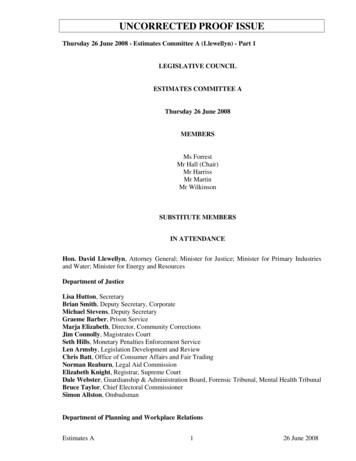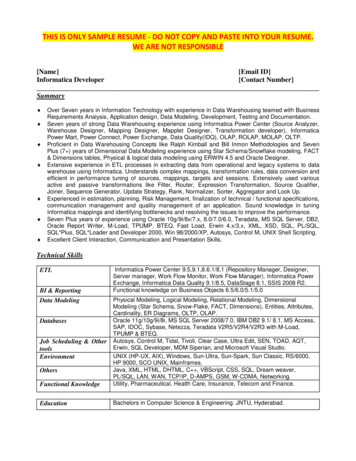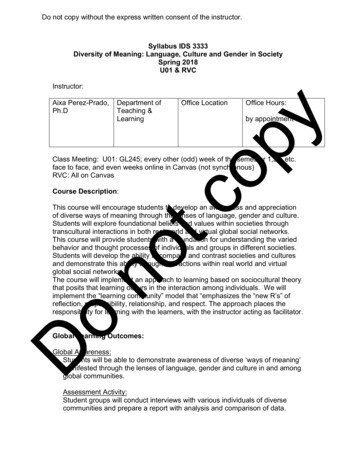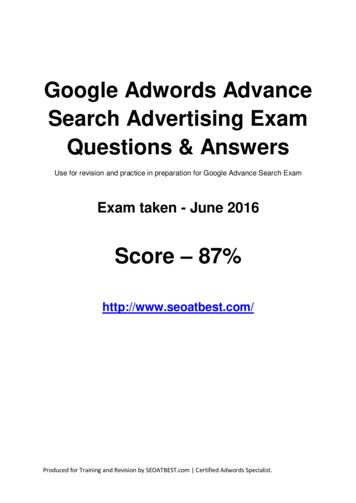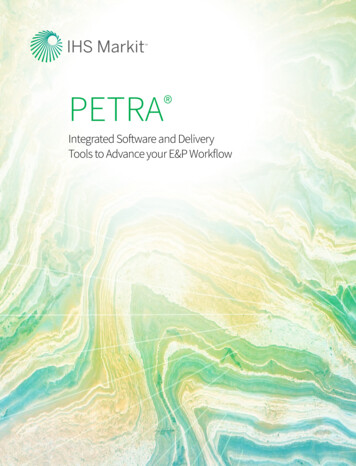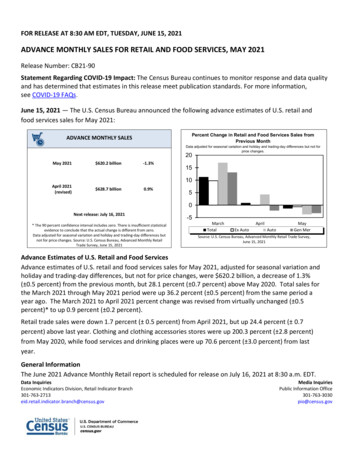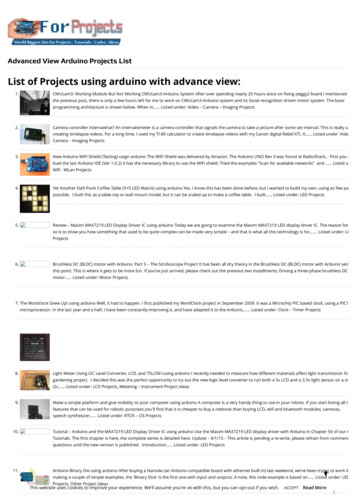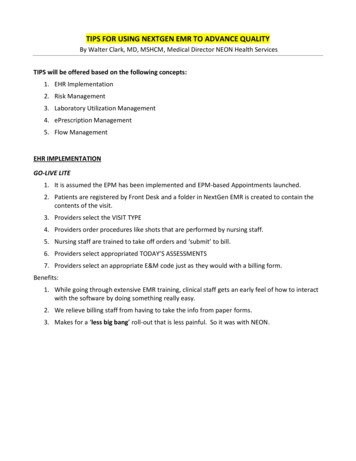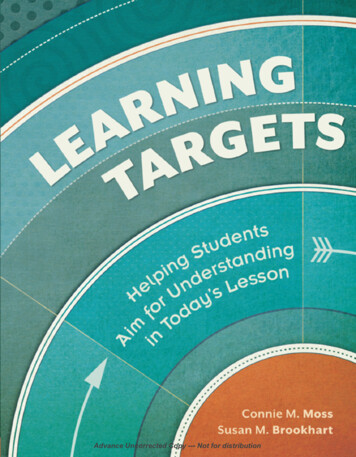
Transcription
Advance Uncorrected Copy --- Not for distribution
1703 N. Beauregard St. Alexandria, VA 22311‑1714 USAPhone: 800-933-2723 or 703-578-9600 Fax: 703-575-5400Website: www.ascd.org E-mail: member@ascd.orgAuthor guidelines: www.ascd.org/writeGene R. Carter, Executive Director; Ed Milliken, Chief Program Development Officer; Carole Hayward,Publisher; Genny Ostertag, Acquisitions Editor; Julie Houtz, Director, Book Editing & Production; MiriamGoldstein, Editor; Lindsey Smith, Senior Graphic Designer; Mike Kalyan, Production Manager; KeithDemmons, Desktop Publishing SpecialistCopyright 2012 ASCD. All rights reserved. It is illegal to reproduce copies of this work in print orelectronic format (including reproductions displayed on a secure intranet or stored in a retrievalsystem or other electronic storage device from which copies can be made or displayed) without theprior written permission of the publisher. By purchasing only authorized electronic or print editionsand not participating in or encouraging piracy of copyrighted materials, you support the rights ofauthors and publishers. Readers who wish to duplicate material copyrighted by ASCD may do sofor a small fee by contacting the Copyright Clearance Center (CCC), 222 Rosewood Dr., Danvers, MA01923, USA (phone: 978-750-8400; fax: 978-646-8600; Web: www.copyright.com). For requests to reprintor to inquire about site licensing options, contact ASCD Permissions at www.ascd.org/permissions,or permission@ascd.org, or 703-575-5749. For a list of vendors authorized to license ASCD e-books toinstitutions, see www.ascd.org/epubs. Send translation inquiries to translations@ascd.org.Printed in the United States of America. Cover art 2012 by ASCD. ASCD publications present avariety of viewpoints. The views expressed or implied in this book should not be interpreted asofficial positions of the Association.All web links in this book are correct as of the publication date below but may have becomeinactive or otherwise modified since that time. If you notice a deactivated or changed link, pleasee-mail books@ascd.org with the words “Link Update” in the subject line. In your message, pleasespecify the web link, the book title, and the page number on which the link appears.ASCD Member Book, No. FY12-8 (July 2012, PSI ). ASCD Member Books mail to Premium (P), Select(S), and Institutional Plus (I ) members on this schedule: Jan., PSI ; Feb., P; Apr., PSI ; May, P; July,PSI ; Aug., P; Sept., PSI ; Nov., PSI ; Dec., P. Select membership was formerly known as Comprehen‑sive membership.PAPERBACK ISBN: 978-1-4166-1441-8ASCD product 112002Also available as an e-book (see Books in Print for the ISBNs).Quantity discounts for the paperback edition only: 10–49 copies, 10%; 50 copies, 15%; for 1,000 ormore copies, call 800-933-2723, ext. 5634, or 703-575-5634. For desk copies: member@ascd.org.Library of Congress Cataloging-in-Publication DataMoss, Connie M.Learning targets : helping students aim for understanding in today’s lesson / Connie M. Moss andSusan M. Brookhart.p. cm.Includes bibliographical references and index.ISBN 978-1-4166-1441-8 (pbk. : alk. paper)1. Lesson planning. 2. Effective teaching. 3. Academic achievement. 4. School improvementprograms. I. Brookhart, Susan M. II. Title.LB1027.4.M67 2012371.3028—dc23201200399722 21 20 19 18 17 16 15 14 13 121 2 3 4 5 6 7 8 9 10 11 12Advance Uncorrected Copy --- Not for distribution
LEARNING TARGETSHelping Students Aim for Understandingin Today’s LessonAcknowledgments.viiIntroduction: Why Should We Pursue Learning Targets?. 11. Learning Targets: A Theory of Action. 72. How to Design Learning Targets. 283. Sharing Learning Targets with Students. 414. Using Learning Targets to Feed Learning Forward. 615. Developing Assessment-Capable Students. 796. Using Learning Targets to Differentiate Instruction. 947. Using Learning Targets to Foster Higher-Order Thinking. 1148. Using Learning Targets to Guide Summative Assessment and Grading. 132.A Learning Target Theory of Action and Educational Leadership:Building a Culture of Evidence. 147Action Tool A. 164Action Tool B. 168Action Tool C. 174Action Tool D. 183Action Tool E. 195Action Tool F. 196Glossary. 199References. 203Index. 213About the Authors. TBDAdvance Uncorrected Copy --- Not for distribution
Introduction: Why ShouldWe Pursue Learning Targets?If you ask a teacher, an administrator, and a student the question “How can we raisestudent achievement?” you’ll likely get a variety of answers. Each answer will reveal apersonal theory of action—that is, the individual’s mental map for what to do in a cer‑tain situation to produce a desired result. Our personal theories of action determinehow we plan, implement, and evaluate our actions. They also guide us in decidingwhich evidence we accept or reject to help us determine whether or not we achievedwhat we set out to do.School districts rarely work with a coherent theory of action on how to raisestudent achievement. As a result, students, teachers, and administrators are oftenworking at odds, each person doing what he or she believes is best and often misun‑derstanding one another’s intentions and actions.This book presents a learning target theory of action that arose from our researchand professional learning partnerships with classrooms, schools, and school dis‑tricts. These experiences compelled us to write a book explaining the crucial rolethat learning targets play in student learning and achievement, teacher expertise,and educational leadership.1Advance Uncorrected Copy --- Not for distribution
2Learning TargetsOur Theory of Action in a NutshellThe most effective teaching and the most meaningful student learning happen when teachers design the right learning target for today’s lesson and use it along with their studentsto aim for and assess understanding.We believe that improving student learning and achievement happens in the imme‑diacy of an individual lesson (what we call “today’s lesson” throughout this book),or it doesn’t happen at all. Teachers design the “right” learning target for today’slesson when they consider where the lesson resides in a larger learning trajectoryand identify the next steps students must take to move toward the overarching under‑standings described in standards and unit goals. Individual lessons should amount tosomething. The right learning target for today’s lesson builds on the learning targetsfrom previous lessons in the unit and connects with learning targets in future lessonsto advance student understanding of important concepts and skills. That’s why weconsider important curricular standards and the potential learning trajectory as wedefine the learning target for today’s lesson. Our goal is to help our students mastera coherent series of learning challenges that will ultimately lead to those standards.Make no mistake, though: this book is not simply about developing the expertiseto design the right target to guide instruction. Our theory of action rests on the cru‑cial distinction that a target becomes a learning target only when students use it toaim for understanding throughout today’s lesson, and students can aim for a targetonly when they know what it is. Therefore, we use the term learning target to referto a target that is shared and actively used by both halves of the classroom learningteam—the teacher and the students.Teachers share the target with their students by telling, showing, and—mostimportant—engaging students in a performance of understanding, an activity thatsimultaneously shows students what the target is, develops their understanding ofthe concepts and skills that make up the target, and produces evidence of their prog‑ress toward the target. Together, teachers and students use that evidence to makedecisions about further learning.Learning targets, when shared with and used by both halves of the classroomlearning team, are key to creating schools where teaching is effective, students arein charge of their own learning, and administrators lead communities of evidencebased decision makers. As part of a unified theory of action, learning targets compelall members of the school to look for and learn from what students are actually doingduring today’s lesson to engage with important and challenging content, developAdvance Uncorrected Copy --- Not for distribution
Introduction: Why Should We Pursue Learning Targets?3increased understanding and skills, and produce strong evidence of their learning.In our experience, adopting a learning target theory of action compels schools toreexamine the fundamentals of teaching and learning that positively and powerfullyinfluence student achievement.What a Learning Target Isn’t and IsA learning target is not an instructional objective. Learning targets differ from instruc‑tional objectives in both design and purpose. As the name implies, instructionalobjectives guide instruction, and we write them from the teacher’s point of view. Theirpurpose is to unify outcomes across a series of related lessons or an entire unit. Bydesign, instructional objectives are too broad to guide what happens in today’s lesson.Learning targets, as their name implies, guide learning. They describe, in languagethat students understand, the lesson-sized chunk of information, skills, and reasoningprocesses that students will come to know deeply. We write learning targets from thestudents’ point of view and share them throughout today’s lesson so that studentscan use them to guide their own learning.Finally, learning targets provide a common focus for the decisions that schoolsmake about what works, what doesn’t work, and what could work better. They helpeducators set challenging goals for what expert teachers and principals should knowand be able to do.How We Organized Our BookOur learning target theory of action compels us to pay close attention to what studentsare actually doing to learn and achieve during today’s lesson. Throughout the book, weillustrate why gathering evidence about what students are doing, rather than whatadults are doing, matters!The book is organized into nine chapters. Chapter 1 situates learning targets ina theory of action that students, teachers, principals, and central-office administra‑tors can use to unify their efforts to raise student achievement and create a cultureof evidence-based, results-oriented practice.Chapter 2 defines learning targets and provides examples of what they are andare not. The chapter explains where learning targets come from, how they differ fromyet are rooted in instructional objectives, and how they propel a formative learningcycle during today’s lesson.Advance Uncorrected Copy --- Not for distribution
4Learning TargetsChapter 3 examines what we mean by “sharing” learning targets. It provides strat‑egies for weaving both the learning target and its criteria for success into the fabricof today’s lesson. This chapter will also discuss designing a strong performance ofunderstanding (Moss, Brookhart, & Long, 2011b, 2011c; Perkins & Blythe, 1994), whichis the most effective way to obtain evidence of student learning.Chapter 4 underlines the importance of “feeding students forward” during a forma‑tive learning cycle to set them up for success. This chapter provides strategies to helpstudents understand how to set mastery goals, produce quality work, and monitortheir own learning progress.Chapter 5 explains the important role that learning targets play in increasing stu‑dents’ capacity to assess their own work and choose effective strategies to monitorand improve that work.In Chapter 6, we consider how learning targets enable teachers to better commu‑nicate exactly what individual students or groups of students should focus on duringa differentiated lesson, as well as to customize success criteria and performances ofunderstanding according to diverse student needs.In Chapter 7, we explain how learning targets promote higher-order thinkingthrough formative assessment and differentiated instruction. Formative assessmentand differentiated instruction help make learning targets that involve higher-orderthinking accessible to all students. We also demonstrate how learning targets fostergoal setting, self-assessment, and self-regulation—processes that influence studentlearning and achievement.Chapter 8 looks at the relationships between learning targets and summativeassessment and grading. We explain how clearly articulated learning targets helpteachers design classroom assessments that summarize achievement over a setof learning targets. The chapter discusses how learning targets connect reportablegoals (broader goals for a unit or reporting period) with narrower goals situated ineach daily lesson.Chapter 9 concludes the book with a discussion of how learning targets focuseducational leadership practices and collaborative professional development efforts.We explain how learning targets help teachers and administrators align their effortsto improve student learning and achievement. Teachers need to know that there isvalue in sharing learning targets and success criteria with their students. They alsoneed to know that administrators will look for what students are actually doing dur‑ing today’s lesson to advance their own understanding and recognize the importanceand value of teaching this way.Advance Uncorrected Copy --- Not for distribution
Introduction: Why Should We Pursue Learning Targets?5Finally, we include an appendix of action tools that we created during our pro‑fessional development work with teachers, schools, and school districts to put ourtheory of action to work across a variety of contexts.How to Use This BookWe suggest that you read this book in the order it was written to grasp the funda‑mental changes in beliefs, reasoning, and practices it promotes. At its core, the bookreframes what learning looks like in the classroom and what educators should countas evidence of student achievement. Reading it from beginning to end will help yourecognize the relational nature of the chapters to a unified theory of action.As you begin designing learning targets, sharing them with your students, andusing them to guide what you do in your classroom, school, and district, use indi‑vidual chapters as references to clarify specific points and clear up misconceptions.For example, if you are struggling to grasp the difference between a learning targetand an instructional objective, Chapters 1 and 2 clarify this crucial distinction. Thetheory of action and action points laid out in Chapter 1 combined with Chapters 2 and3 provide context and practical strategies for reframing learning at the classroom leveland explain why the role that students play in their own learning matters. Chapters 6and 7 deepen understanding of how differentiated instruction and formative assess‑ment combine to promote learning and higher-order thinking for all students. Schooladministrators will find practical ideas throughout the book, but we suggest a closereading of Chapters 1, 2, and 9 to bring coherence to professional learning and schoolimprovement initiatives.We hope the learning target theory of action and action points in this book leadto courageous conversations. If we truly intend to raise student achievement, thenall members of the school—students, teachers, principals, and central-office admin‑istrators—must recognize who is achieving and who is not, and hold themselves andothers accountable to do something about it.Advance Uncorrected Copy --- Not for distribution
1Learning Targets:A Theory of ActionHow to Catch a Monkey in the Wild: A Cautionary TaleThere are probably many ways to catch a monkey in the wild. One of the most effec‑tive is insidious in its simplicity.The hunter gets a coconut and bores a small, cone-shaped hole in its shell, justlarge enough to allow a monkey to squeeze its paw inside. The hunter drains thecoconut, ties it down, puts a piece of orange inside, and waits. Any monkey thatcomes by will smell the orange, put its paw inside the coconut to grab the juicy treat,and become trapped in the process. Capturing the monkey doesn’t depend on thehunter’s prowess, agility, or skill. Rather, it depends on the monkey’s tenacious holdon the orange, a stubborn grip that renders it blind to a simple, lifesaving option:opening its paw.Make no mistake: the hunter doesn’t trap the monkey. The monkey’s abidingtendency to stick firmly to its decision, ignore evidence to the contrary, and neverquestion its actions is the trap that holds it captive.7Advance Uncorrected Copy --- Not for distribution
8Learning TargetsThe Beliefs That We Hold and the Beliefs That Hold UsThe beliefs that we hold also hold us. Our beliefs are the best predictors of our actionsin any situation (Schreiber & Moss, 2002). And, like the monkey’s death grip on theorange, our beliefs are deeply rooted, often invisible, and highly resistant to change.That’s why so many “tried-but-not-true” methods remain alive and well in our class‑rooms despite clear evidence of their ineffectiveness. Take round-robin reading, forexample. This practice has been rightly characterized as one of the most ineffectualpractices still used in classrooms. You know the activity: the first student in a rowreads the first paragraph from a book, the second student reads the second paragraph,and so on. Round-robin reading has long been declared a “disaster” in terms of listen‑ing and meaning-making (Sloan & Latham, 1981), and the reading comprehension itpromotes pales in comparison to the effects of silent reading (Hoffman & Rasinski,2003). So why do teachers still choose it for their students, and why do the principalswho observe it in classrooms continue to turn a blind eye?As our cautionary tale illustrates, it is essential for us to recognize our tendencyto hold on to unexamined beliefs and practices. Each of us has our own mental map,a theory of action that directs our behavior in any situation (Argyris & Schön, 1974).What’s tricky is that we actually operate under dual theories of action: an espousedtheory and a theory in use. Our espoused theory is what we say we believe works ina given situation, whereas our theory in use is what actually guides our day-to-dayactions (Argyris & Schön, 1974). For instance, if you ask a teacher what he believesmakes assignments meaningful, he might tell you that students should be engaged inauthentic tasks. Yet a visit to his classroom might reveal students copying vocabularydefinitions from their textbooks. If you want to uncover what someone truly believesabout any situation, look for what that person actually does in that situation.Learning involves detecting and eliminating errors (Argyris & Schön, 1978). Whensomething isn’t working, our first reaction is to look for a new strategy—a way to fixthe problem—that will allow us to hold on to our original beliefs, and to ignore anyresearch or suggestions that go against our beliefs. Argyris and Schön (1974) call thisbelief-preserving line of reasoning single-loop learning.Deeper levels of learning happen when we uncover what is not working and usethat information to call our beliefs into question. When we question our beliefs andhold them up to critical scrutiny, we engage in the belief-altering process of double-loopAdvance Uncorrected Copy --- Not for distribution
Learning Targets: A Theory of Action9learning (Argyris & Schön, 1974). Double-loop learning is how vibrant organizationschange and grow (Argyris & Schön, 1978; Schön, 1983).When Nobel laureate and astrophysicist Arno Penzias, honored for his discovery ofcosmic microwave background radiation, was asked what accounted for his success,he replied, “I went for the jugular question. . . . Change starts with the individual. So thefirst thing I do each morning is ask myself, ‘Why do I strongly believe what I believe?’”The best way to eliminate the disparity between what we say and what we do andto invite the jugular questions is to forge a unified theory of action, shared across aschool or district, that both explains and determines the actions that members takeas individuals and as a community.The Learning Target Theory of ActionIn the introduction to this book, we included a “nutshell statement” of our theory ofaction: The most effective teaching and the most meaningful student learning happenwhen teachers design the right learning target for today’s lesson and use it along withtheir students to aim for and assess understanding. Our theory grew from our continu‑ing research with educators focused on raising student achievement through forma‑tive assessment processes (e.g., Brookhart, Moss, & Long, 2009, 2010, 2011; Moss &Brookhart, 2009; Moss, Brookhart, & Long, 2011a, 2011b, 2011c). What we discoveredand continue to refine is an understanding of the central role that learning targetsplay in schools.Learning targets are student-friendly descriptions—via words, pictures, actions, orsome combination of the three—of what you intend students to learn or accomplishin a given lesson. When shared meaningfully, they become actual targets that studentscan see and direct their efforts toward. They also serve as targets for the adults in theschool whose responsibility it is to plan, monitor, assess, and improve the quality oflearning opportunities to raise the achievement of all students.When educators share learning targets throughout today’s lesson (a subject wediscuss further in Chapter 3), they reframe what counts as evidence of expert teach‑ing and meaningful learning. And they engage in double-loop learning to question themerits of their present beliefs and practices.Advance Uncorrected Copy --- Not for distribution
10Learning TargetsThe Multiple Effects of a LearningTarget Theory of ActionEffects on TeachersLearning targets drive effective instructional decisions and high-quality teaching.Teaching expertise is not simply a matter of time spent in the classroom. In truth, thenovice-versus-veteran debate presents a false dichotomy. Teachers of any age and atany stage of their careers can exhibit expertise. What expert teachers have in com‑mon is that they consistently make the on-the-spot decisions that advance studentachievement (Hattie, 2002).Designing and sharing specific learning targets to enhance student achievementin today’s lesson requires and continually hones teachers’ decision-making expertise.Teachers become better able to Plan and implement effective instruction; Describe exactly what students will learn, how well they will learn it, andwhat they will do to demonstrate that learning; Use their knowledge of typical and not-so-typical student progress to scaffoldincreased student understanding; Establish teacher look-fors to guide instructional decisions; and Translate success criteria into student look-fors that promote the develop‑ment of assessment-capable students.Guided by learning targets, teachers partner with their students during a forma‑tive learning cycle to gather and apply strong evidence of student learning to raiseachievement (Moss & Brookhart, 2009). And they make informed decisions abouthow and when to differentiate instruction to challenge and engage all students inimportant and meaningful work.Effects on StudentsWhen students, guided by look-fors, aim for learning targets during today’s lesson,they become engaged and empowered. They are better able to Compare where they are with where they need to go;Set specific goals for what they will accomplish;Choose effective strategies to achieve those goals; andAssess and adjust what they are doing to get there as they are doing it.Advance Uncorrected Copy --- Not for distribution
Learning Targets: A Theory of Action11Students who take ownership of their learning attribute what they do well to deci‑sions that they make and control. These factors not only increase students’ ability toassess and regulate their own learning but also boost their motivation to learn as theyprogressively see themselves as more confident and competent learners.Effects on PrincipalsWhen building principals look for what students are doing to hit learning targets duringtoday’s lesson, they improve their leadership practices. They become better able to Recognize what does and does not work to promote learning and achieve‑ment for all students and groups of students at the classroom level; Use up-to-the-minute student performance data to inform decision making;and Provide targeted feedback to individual teachers, groups of teachers, andbuilding faculty as a whole.Guided by learning targets, principals can promote coherence between actionsat the classroom level and actions at the school level. They can also better allocateresources to promote student learning and lead professional development efforts intheir building.Effects on Central-Office AdministratorsA learning target theory of action also enables central-office administrators to gatherup-to-the-minute data about what is working in their classrooms and schools. Theybecome better able to Identify key elements that support a districtwide strategy to raise studentachievement; Communicate the relationship among these elements in an integrated andcoherent way; and Use strong and cohesive performance data for decision making.Guided by learning targets, central-office administrators can implement effectivestrategies to increase student achievement across buildings with different needs andunique characteristics shaped by the students, teachers, administrators, parents,and community members who work together in each building. They can developAdvance Uncorrected Copy --- Not for distribution
12Learning Targetsand manage human capital to carry out their strategy for improvement, gain districtcoherence, and make the strategy scalable and sustainable.Making each lesson meaningful and productive requires collective vigilance. It’snot enough to “know” what works. Each day, students suffer the consequences ofthe mismatch between what we say is important and what actually happens duringtoday’s lesson.The Nine Action PointsA learning target theory of action embodies the relationship among essential content,effective instruction, and meaningful learning. The nine action points that followadvance this theory of action and provide context for the ideas and suggestions inthis book:1. Learning targets are the first principle of meaningful learning and effectiveteaching.2. Today’s lesson should serve a purpose in a longer learning trajectory towardsome larger learning goal.3. It’s not a learning target unless both the teacher and the students aim for itduring today’s lesson.4. Every lesson needs a performance of understanding to make the learning targetfor today’s lesson crystal clear.5. Expert teachers partner with their students during a formative learning cycleto make teaching and learning visible and to maximize opportunities to feedstudents forward.6. Setting and committing to specific, appropriate, and challenging goals lead toincreased student achievement and motivation to learn.7. Intentionally developing assessment-capable students is a crucial step towardclosing the achievement gap.8. What students are actually doing during today’s lesson is both the source ofand the yardstick for school improvement efforts.9. Improving the teaching-learning process requires everyone in the school—teachers, students, and administrators—to have specific learning targets andlook-fors.Advance Uncorrected Copy --- Not for distribution
Learning Targets: A Theory of Action13Action Point 1: Learning targets are the first principleof meaningful learning and effective teaching.The purpose of effective instruction is to promote meaningful learning that raisesstudent achievement. The quality of both teaching and learning is enhanced whenteachers and students aim for and reach specific and challenging learning targets.It’s logical, really. To reach a destination, you need to know exactly where you areheaded, plan the best route to get there, and monitor your progress along the way.When teachers take the time to plan lessons that focus on essential knowledge andskills an
student achievement?” you’ll likely get a variety of answers. Each answer will reveal a personal theory of action—that is, the individual’s mental map for what to do in a cer‑ tain situation to produce a desired result. Our personal theories of action determine how we plan, imple
